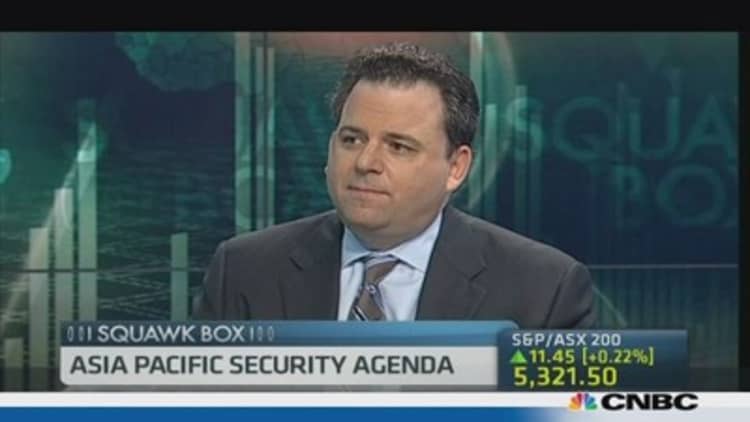
As the Pentagon outlined its new proposed budget Monday afternoon, some clear winners and losers emerged.
Winners: Companies and communities around big defense programs like the F-35 multi-role fighter.
Losers: Companies and communities around military bases, especially those which may face closure.
"The choices ahead will define our defense institutions for years to come," said Defense Secretary Chuck Hagel.
In outlining a series of cuts, the Defense Department had to make tough choices—and for the spending cuts to take effect, they must pass successfully through a bitterly divided Congress during an election year. Still, the proposals presented by Hagel give some indication of what may be to come.
Holders of U.S. defense stocks, at least, expressed relief that the budget appeared to spare most major arms manufacturers. Shares of Lockheed Martin, Northrop, General Dynamics and Raytheon all hit 52-week highs on Monday.
The Pentagon remains committed to Lockheed Martin's F-35 Joint Strike Fighter, the most expensive defense program in history. Secretary Hagel also wants to stay on track with a new bomber program for which Lockheed and Boeing may submit bids, as well as the new air refueling tanker, built by Boeing.
The Pentagon is also choosing the more expensive Global Hawk unmanned system over the less expensive but older U2, a clear win for Northrop Grumman. "Over the last several years, DoD has been able to reduce the Global Hawk's operating costs," Hagel told reporters.
(Read more: Chart—US spends more on arms than next 10 nations combined)
The Pentagon also wants to invest $1 billion in next-generation jet engine technology. "This new funding will also help ensure a robust industrial base—itself a national strategic asset," he said.
The entire fleet of A-10 aircraft will be retired, closing a long run for the air-to-ground attack plane. "The 'Warthog' is a venerable platform, and this was a tough decision," said Hagel. "But the A-10 is a 40-year-old single-purpose airplane originally designed to kill enemy tanks on a Cold War battlefield. It cannot survive or operate effectively where there are more advanced aircraft or air defenses."
The Air Force will also reduce the number of Predators and Reapers it buys, after a long run in Iraq and Afghanistan by the unmanned aerial vehicles built by General Atomics Aeronautical Systems.
As much as Lockheed Martin has won with continued support of the F-35, it loses with the Navy. Both Lockheed and General Dynamics make variants of the Littoral Combat Ship (LCS), which has been the subject of controversy over its cost and performance.
(Read more: Memo says VA data breach 'practically unavoidable')
"I am concerned that the Navy is relying too heavily on the LCS to achieve its long-term goals for ship numbers," said Hagel, affirming plans to stop buying any ships beyond the 32 already agreed to.
The cuts could still end up being deeper. The Pentagon outlook is based on Congressional approval of $115 billion in extra spending over five years above current sequestration levels, money the President will ask for in his budget. If Congress says "no," and full sequester continues into the next fiscal year, the Air Force will ground its entire KC-10 tanker fleet and a number of Global Hawks. The Navy would slow down the purchase of destroyers and stop for two years all purchases of the F-35s being built for aircraft carriers.
Military defense spending by GDP
| Rank | Country | (% of GDP) | Date of information |
|---|---|---|---|
| 1 | South Sudan | 10.32 | 2012 |
| 2 | Oman | 8.61 | 2012 |
| 3 | Saudi Arabia | 7.98 | 2012 |
| 4 | Israel | 5.69 | 2012 |
| 5 | Jordan | 4.65 | 2012 |
| 6 | Azerbaijan | 4.64 | 2012 |
| 7 | Algeria | 4.48 | 2012 |
| 8 | Russia | 4.47 | 2012 |
| 9 | United States | 4.35 | 2012 |
| 10 | Lebanon | 4.04 | 2012 |
Source: Source: Central Intelligence Agency
While thousands of Americans working on these major programs through contracts will continue to have work, it is a different story for military personnel. Half of all defense spending goes to pay and benefits, which have risen 40 percent more than the private sector since the "war on terror" began in 2001.
Active duty military personnel levels will be reduced 13 percent, with the biggest cuts to the Army, losing at least 70,000 soldiers. Other changes are already under way. For example, newly commissioned Marine officers are having to wait months without pay before beginning at The Basic School in Quantico, Va.
As for salaries, the Pentagon is still proposing a raise for troops next fiscal year, but a small one, only one percent, while pay will be frozen for top military brass. Base commissaries, which currently receive $1.4 billion in government subsidies to keep prices low, will lose $1 billion of that. Housing allowances, which have been 100 percent, will be reduced to 95 percent.
(Read more: )
And while there are no hard figures on how much active duty and retired personnel will have to pay for health care deductibles and co-pays, "We will ask retirees and some active-duty family members to pay a little more," Hagel said.
Exempt from this will be those retired due to medical reasons, along with their families, as well as survivors of those killed on active duty. Current retirement benefits, generally considered very generous, are not being changed for now.

If Congress approves the changes—and that's a big if—it will mean fewer people in the military with a little less spending power, and that will affect businesses and communities around military bases which depend on them.
For some, military bases will disappear altogether. The Pentagon wants Congress to begin another round of base closings in 2017. Already some communities are worried. "This concern comes natural to Texas, home to 15 military installations that keep 250,000 military and civilian employees in paychecks, for an estimated $149 billion in economic activity," reported the San Antonio Express-News last month.
After 13 years of war, the longest conflict in U.S. history, America could end up with its smallest fighting force since before World War II, but one the Pentagon hopes is more nimble, rapidly deployable, and technologically advanced. (The number of special forces troops would actually be increased slightly under the Pentagon proposals.)
"These recommendations will adapt and reshape our defense enterprise," said Hagel, "so that we can continue protecting this nation's security in an era of unprecedented uncertainty and change."
—By CNBC's Jane Wells; Follow her on Twitter: @janewells. CNBC Earnings Editor Juan Aruego contributed to this report.



